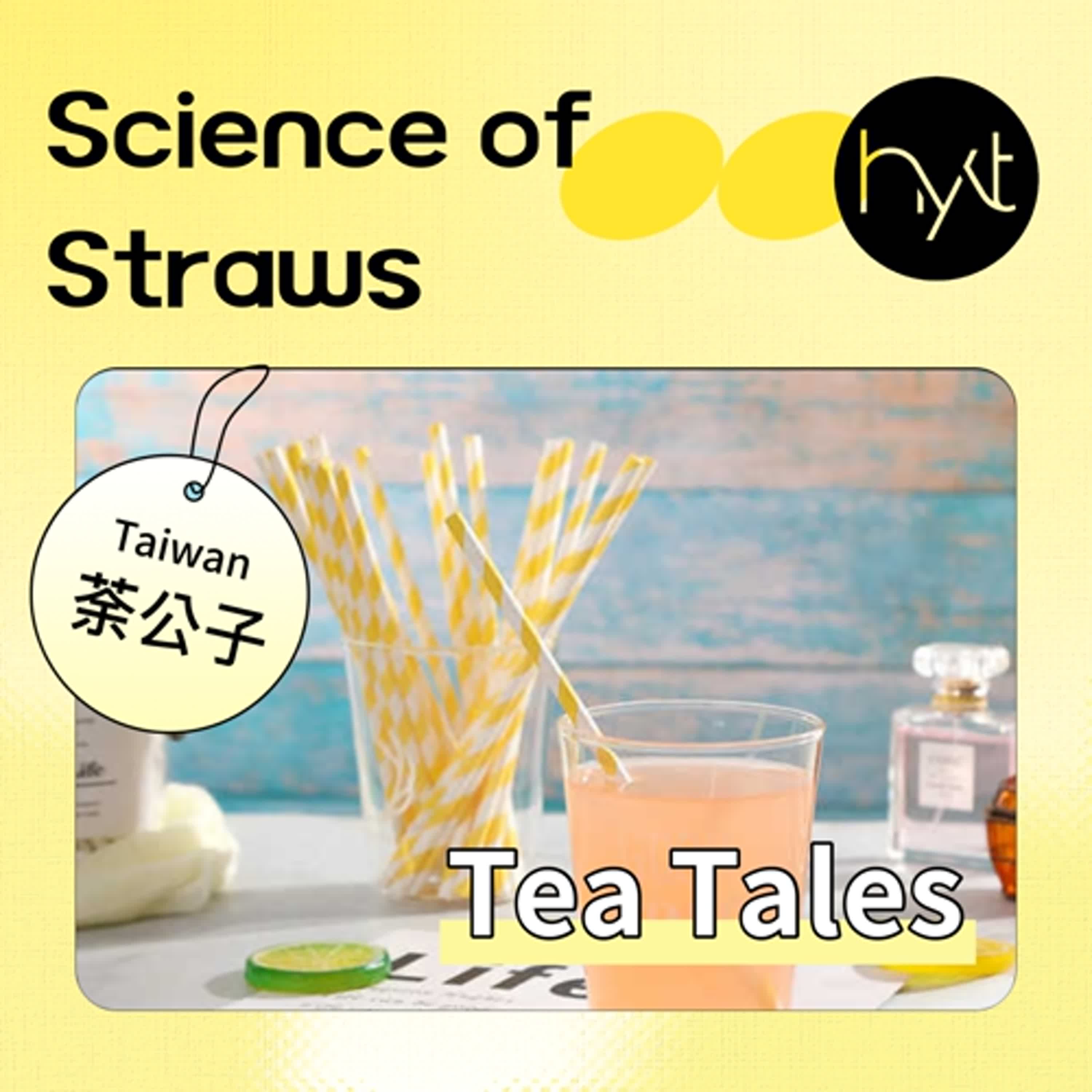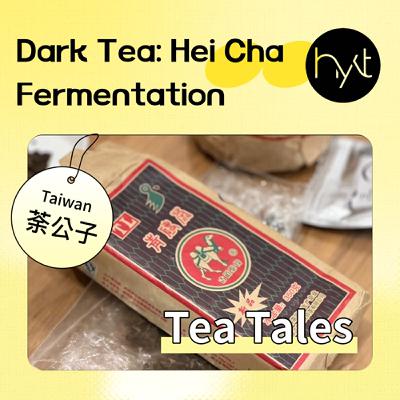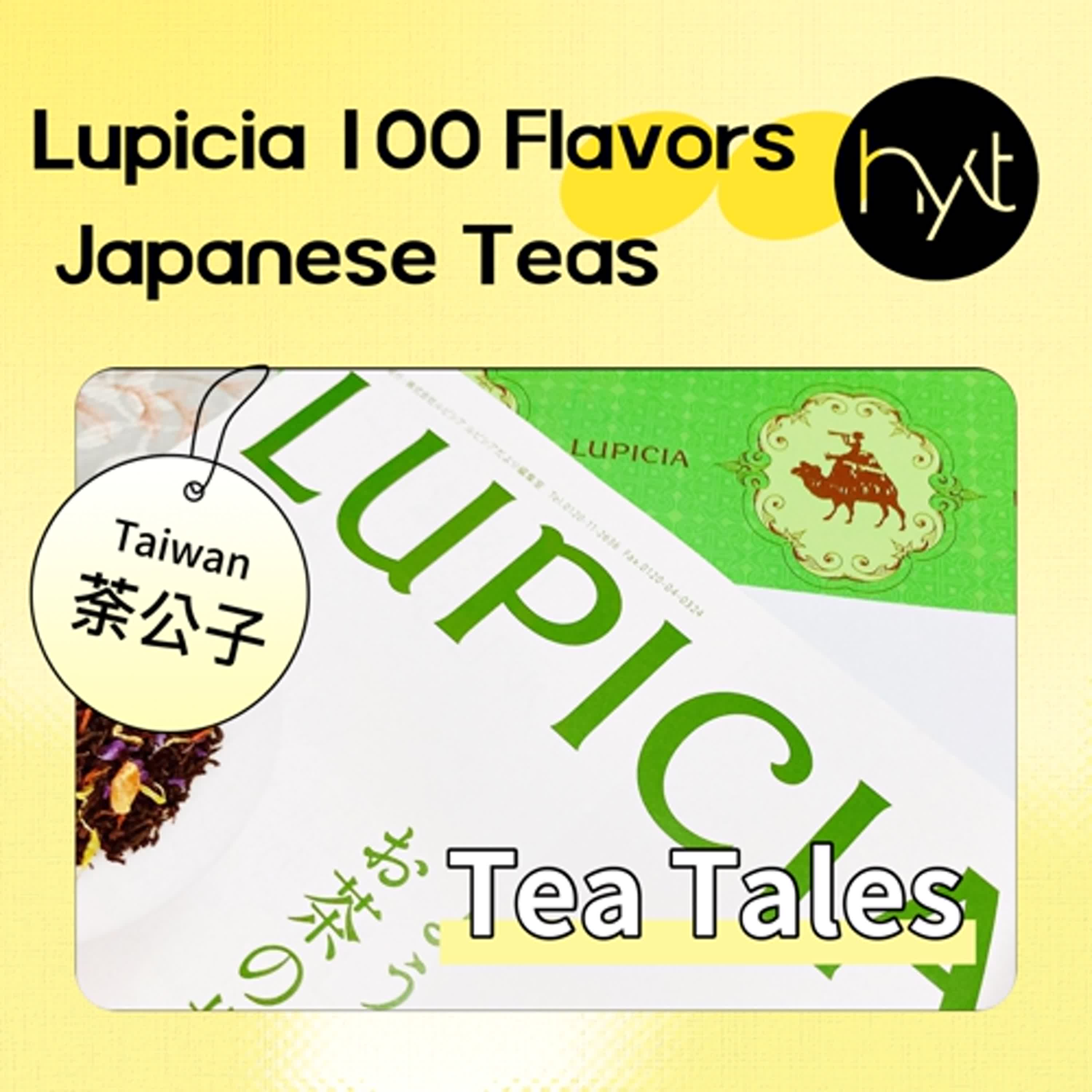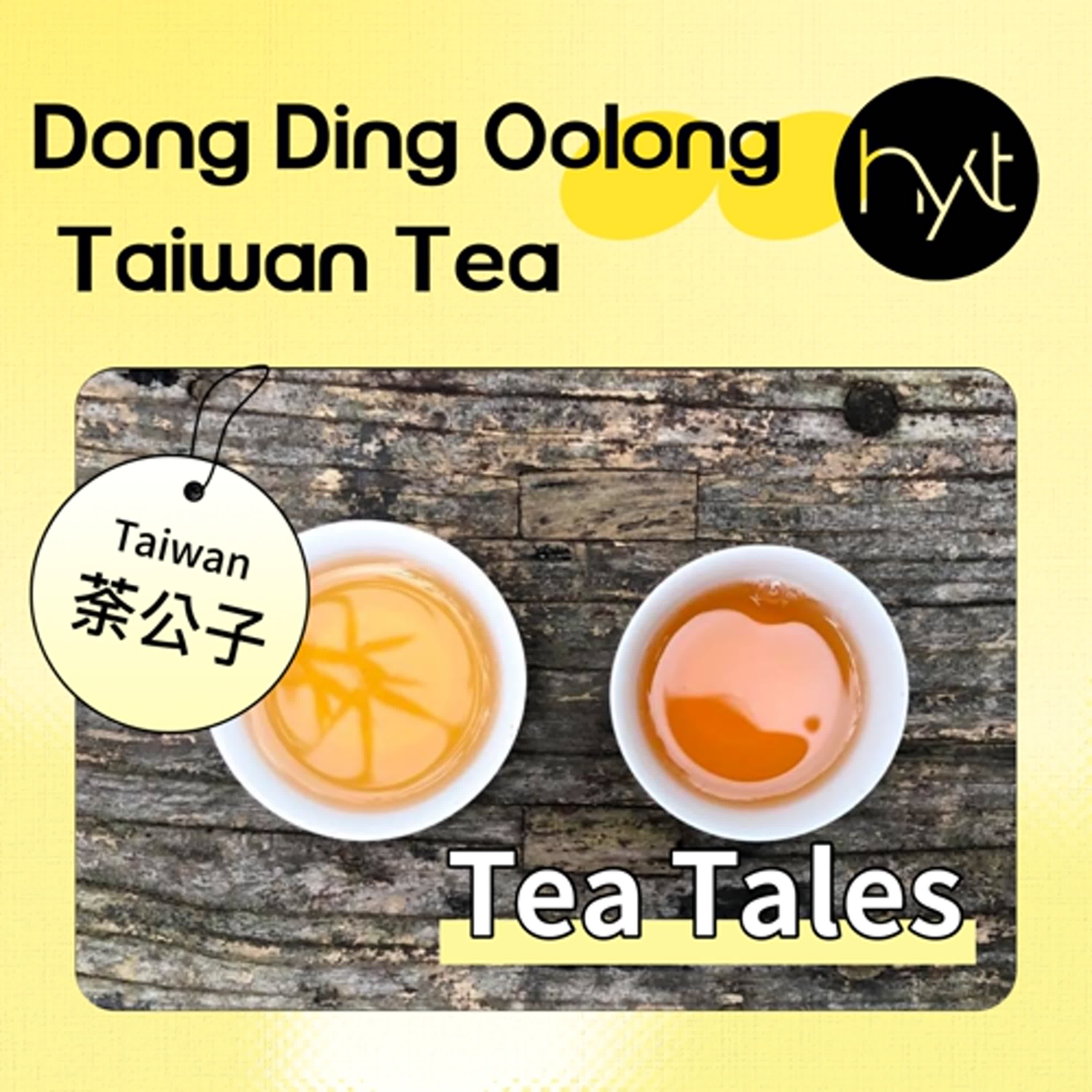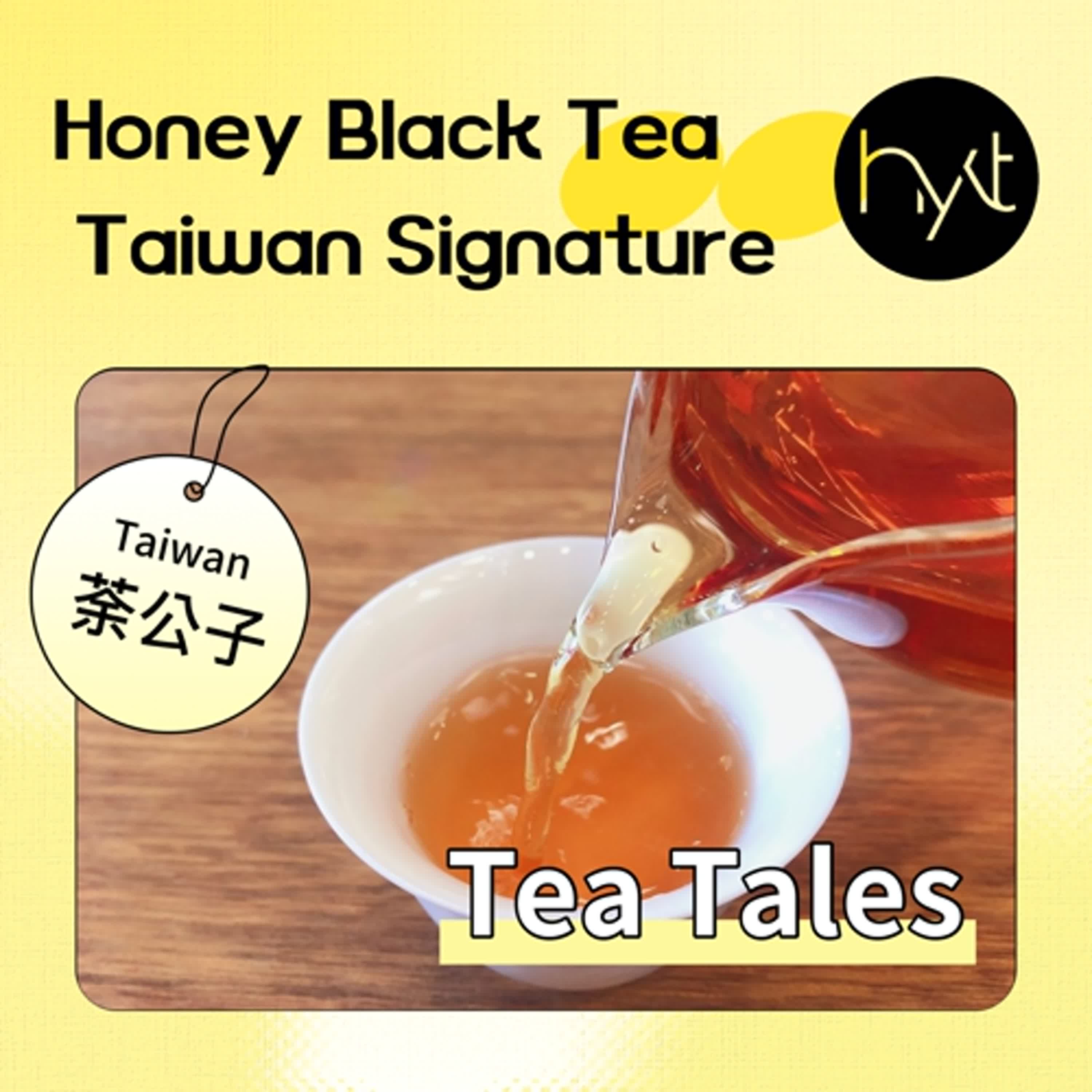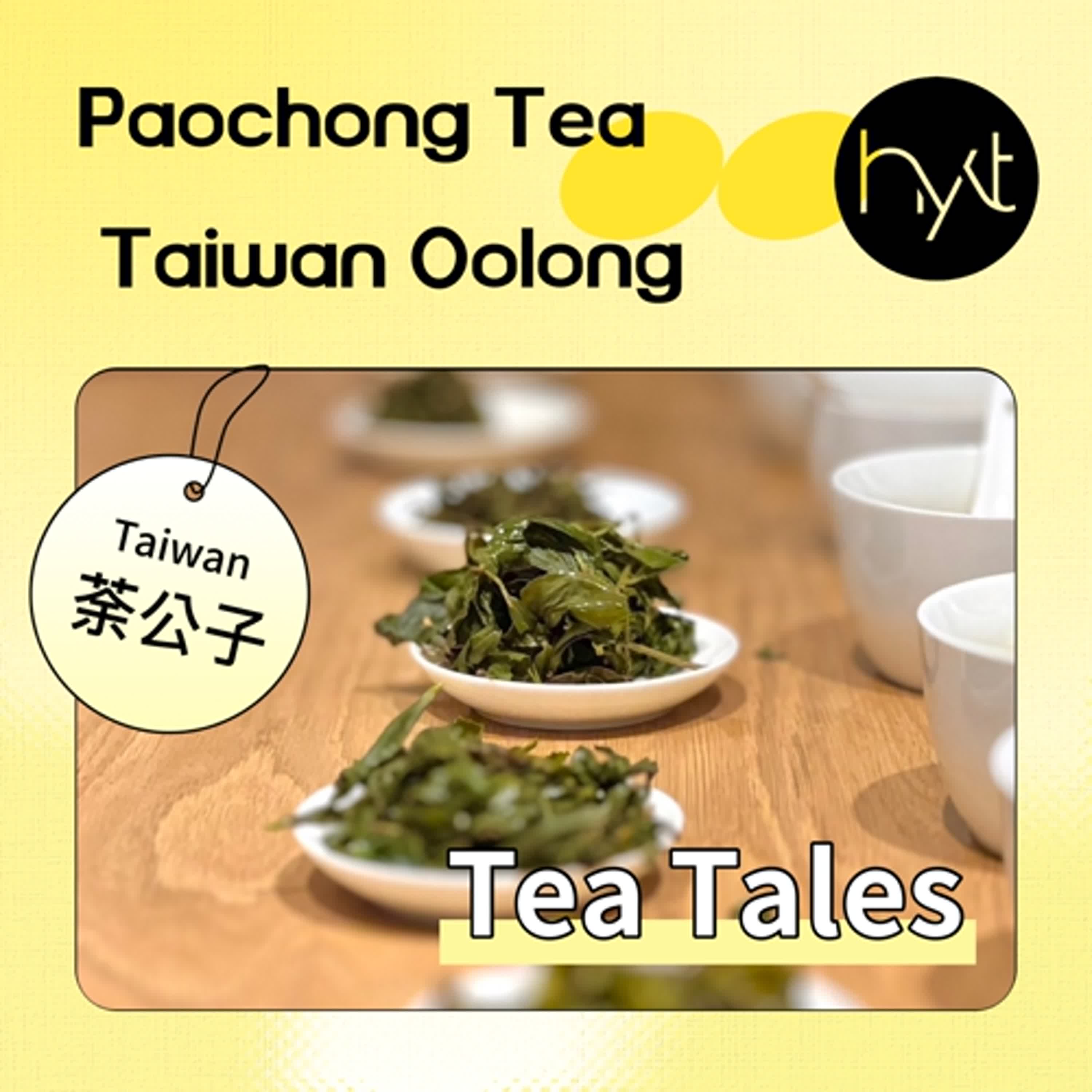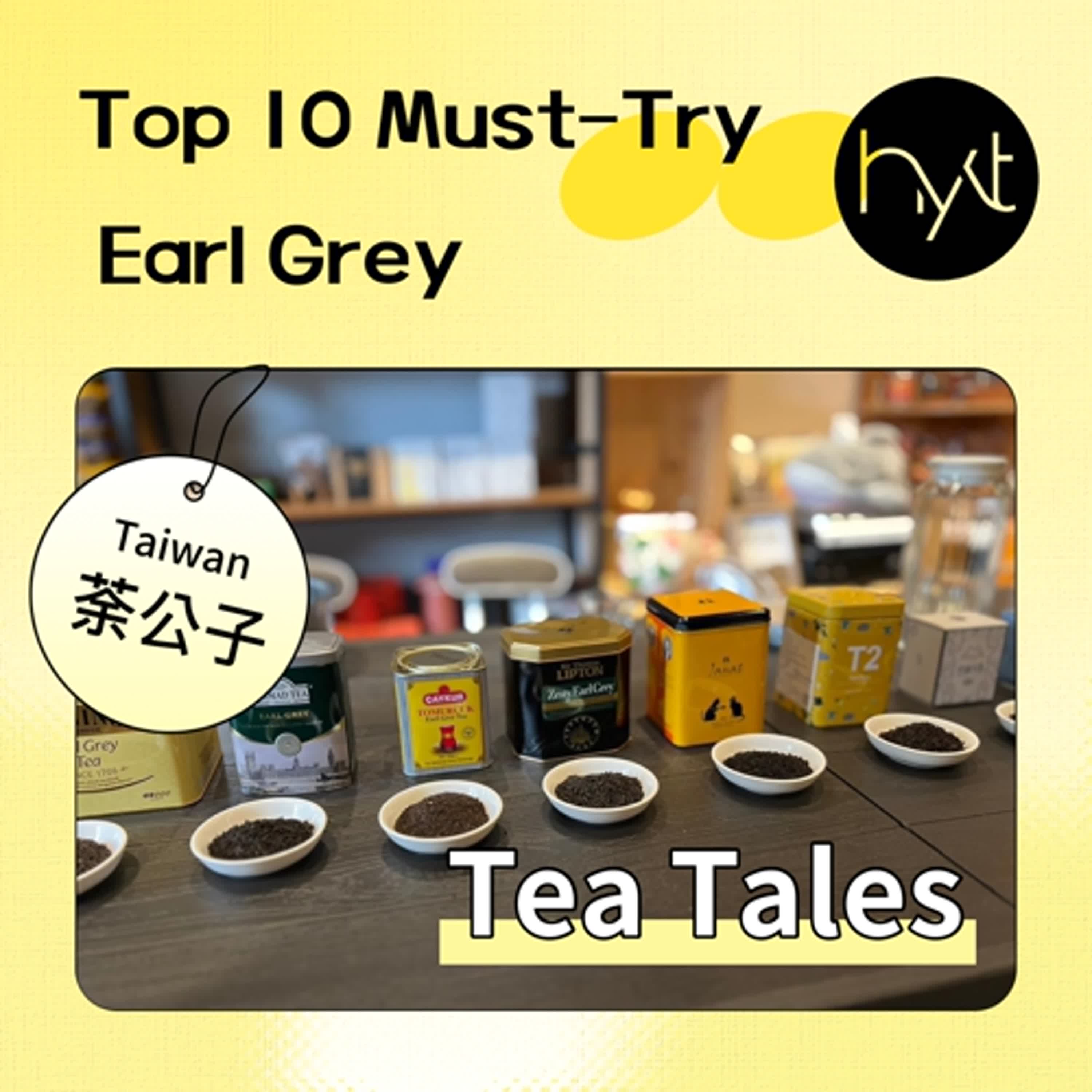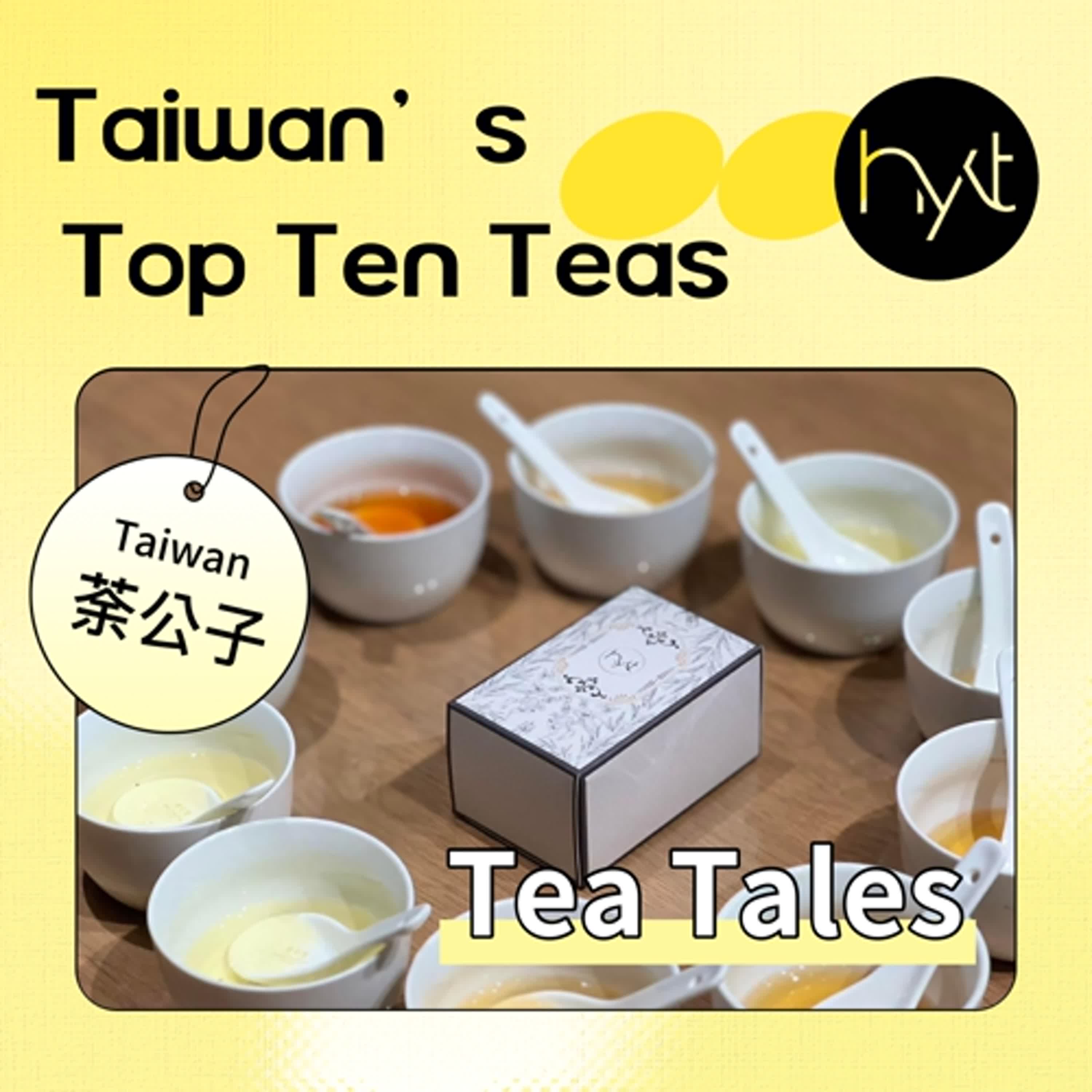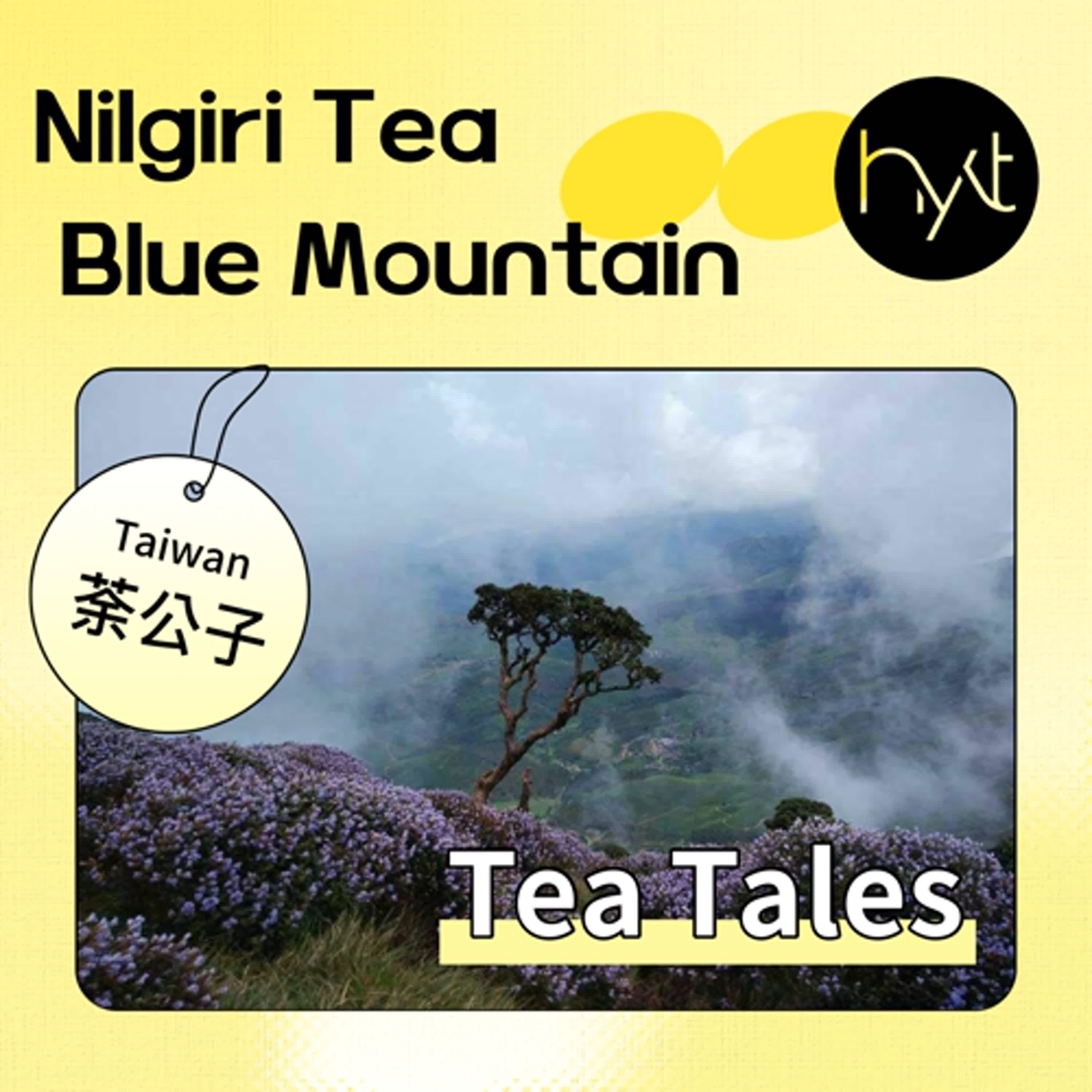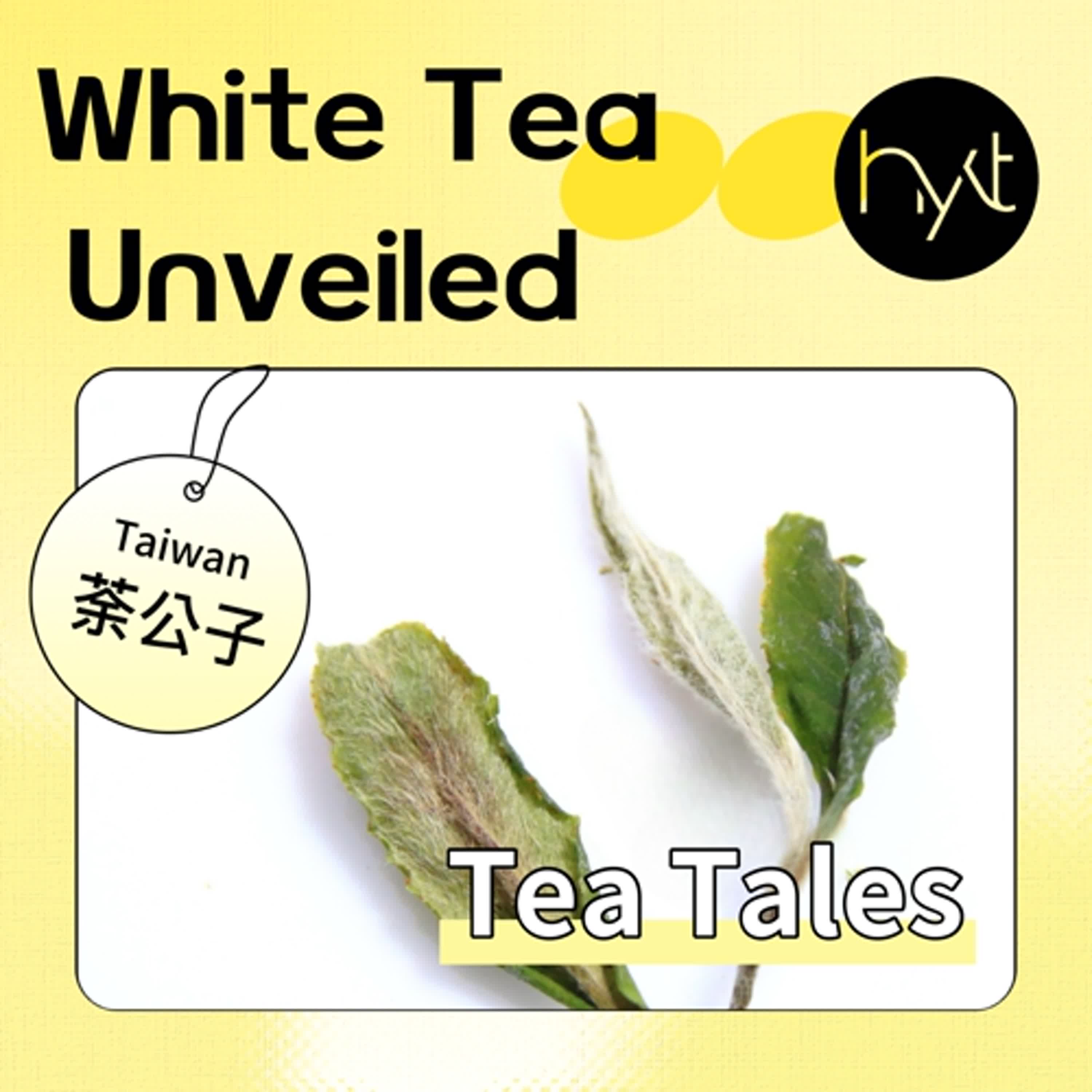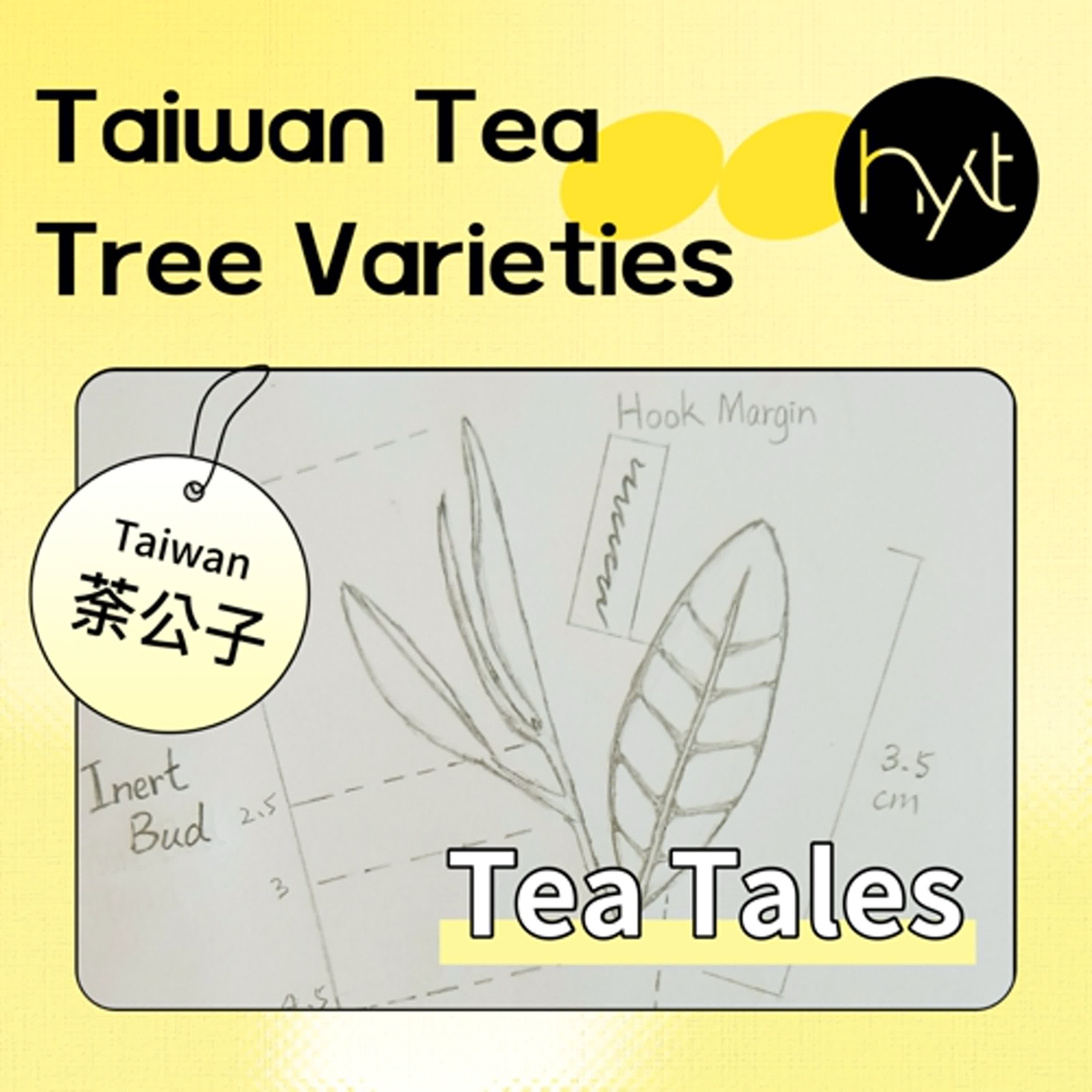Discover 荼公子的世界茶葉大賞!Let's have a TEA PARTY
荼公子的世界茶葉大賞!Let's have a TEA PARTY

荼公子的世界茶葉大賞!Let's have a TEA PARTY
Author: 荼公子aka奶茶傳教士
Subscribed: 22Played: 209Subscribe
Share
© 荼公子aka奶茶傳教士
Description
由荼公子aka奶茶傳教士主持的節目系列,身為飲品研發師撰寫《奶茶風味學》後,認為萬物皆可入茶。從各國茶葉的歷史與文化的主題,錄製包括線上課程、跨界語談的職業者的生活記錄,帶你跟著茶師了解飲料研發、茶葉界工作者的日常。
邀約、合作 : hanyi2016tea@gmail.com
部落格看這:www.hanyitea.tw
Powered by Firstory Hosting
101 Episodes
Reverse
Keywords: tea in comics, tea in manga, tea culture, tea symbolism, tea and storytelling, tea in Japanese culture, tea and character development, famous tea-themed manga, tea and aesthetics, traditional tea in art In this episode of Tea Chronicles, we dive into the fascinating intersection between tea and comics, exploring how this beloved beverage is depicted in manga and graphic novels. From heartwarming slice-of-life stories to historical and fantasy narratives, tea plays a symbolic and cultural role, influencing storytelling, character development, and world-building. We’ll explore some iconic tea-related manga like Tea for Two and Afternoon Tea Detective, examining how tea ceremonies, aesthetics, and traditions are brought to life in these illustrated worlds. How does tea reflect the emotions of characters? What role does it play in the artistic vision of comic creators? Join us as we steep ourselves in the visual storytelling of tea culture. 🔗 Read more on our website: https://www.hanyitea.tw/single-post/comics/ 🌿 Key Highlights:Tea as a Cultural Symbol: Discover how tea is used as a theme in storytelling and world-building in manga and comics.Famous Tea-Themed Comics: We explore well-known works such as Tea for Two and Afternoon Tea Detective, which celebrate tea culture.Tea and Character Development: How tea scenes and rituals influence mood, emotions, and personalities of fictional characters.Aesthetics of Tea in Art: From serene tea houses to traditional tea ceremonies, we discuss how artists visually represent the beauty of tea culture.The Role of Tea in Japanese Storytelling: A look into how tea is woven into classic and modern narratives to evoke nostalgia, tradition, or mystery. ▋Become a YouTube Member Love our content? Support us with a small contribution and enjoy exclusive member benefits! Join here ▋Subscribe to our YouTube Channel Never miss an episode! Subscribe to the Han-Yi Tea channel for more tea insights. Subscribe here ▋Business Inquiries Interested in collaborations? Contact us at: hanyi2016tea@hanyitea.tw ▋Follow Us on Other PlatformsFacebook: Han-Yi Tea FacebookInstagram: Cha.Cha.Du InstagramOfficial Website: Han-Yi Tea Official WebsiteMilk Tea Enthusiasts Line Group: Join Here Support this show with a small donation: Donate here Leave a comment and share your thoughts on this episode: Comment here 小額贊助支持本節目: https://open.firstory.me/user/ckqw5eak2g4820939s2ieb4wv 留言告訴我你對這一集的想法: https://open.firstory.me/user/ckqw5eak2g4820939s2ieb4wv/comments Powered by Firstory Hosting
Keywords: straws, drinking straws, straw history, straw materials, environmental impact, reusable straws, straw etiquette, beverage culture, straw alternatives, sustainable drinking In this episode of Tea Chronicles, we delve into the fascinating world of straws, exploring their rich history, diverse materials, and their indispensable role in beverage culture. From ancient civilizations to modern-day innovations, straws have evolved significantly, impacting how we enjoy our favorite drinks. We'll uncover the origins of straws, dating back to ancient Sumerians who used natural materials for drinking. Fast forward to today, and we see a plethora of straw types, including plastic, stainless steel, glass, silicone, paper, bamboo, and even sugarcane residue straws. Each material offers unique benefits and challenges, especially concerning environmental sustainability and user experience. Join us as we discuss the proper etiquette of using straws, particularly in popular beverages like bubble tea, where the technique of inserting the straw can enhance the drinking experience. We'll also address the environmental concerns associated with single-use plastic straws and explore eco-friendly alternatives that are gaining popularity. 🔗 Read more on our website: https://www.hanyitea.tw/single-post/straw/ 🌿 Key Highlights:Historical Journey: Tracing the evolution of straws from ancient Sumerian times to contemporary usage.Material Diversity: Exploring various straw materials—plastic, stainless steel, glass, silicone, paper, bamboo, and sugarcane residue—and their respective pros and cons.Environmental Impact: Discussing the ecological footprint of different straws and the rise of sustainable alternatives.Proper Usage Techniques: Tips on the correct way to insert and use straws, especially in beverages sealed with film, to prevent spills and enhance hygiene.Cultural Significance: Understanding the role of straws in different beverage traditions and their integration into modern drink experiences. ▋Become a YouTube Member Love our content? Support us with a small contribution and enjoy exclusive member benefits! Join here ▋Subscribe to our YouTube Channel Never miss an episode! Subscribe to the Han-Yi Tea channel for more tea insights. Subscribe here ▋Business Inquiries Interested in collaborations? Contact us at: hanyi2016tea@hanyitea.tw ▋Follow Us on Other PlatformsFacebook: Han-Yi Tea FacebookInstagram: Cha.Cha.Du InstagramOfficial Website: Han-Yi Tea Official WebsiteMilk Tea Enthusiasts Line Group: Join Here Support this show with a small donation: Donate here Leave a comment and share your thoughts on this episode: Comment here 小額贊助支持本節目: https://open.firstory.me/user/ckqw5eak2g4820939s2ieb4wv 留言告訴我你對這一集的想法: https://open.firstory.me/user/ckqw5eak2g4820939s2ieb4wv/comments Powered by Firstory Hosting
Keywords: dark tea, Chinese tea, post-fermented tea, Pu-erh tea, Liu Bao tea, Fuzhuan tea, tea fermentation, tea history, tea health benefits, how to brew dark tea, aged tea In this episode of Tea Chronicles, we delve into the world of dark tea, one of China’s six major tea types, known for its unique post-fermentation process and rich history. Dark tea dates back to the Tang Dynasty and played a crucial role in ancient trade along the Silk Road and Tea Horse Road. Its distinct production method, wo dui fermentation, enhances its deep, mellow flavors and earthy aroma over time. Join us as we explore the fascinating varieties of dark tea, including Pu-erh ripe tea, Liu Bao tea, and Fuzhuan brick tea, and uncover the remarkable health benefits linked to digestion, cholesterol reduction, and gut health. Plus, we’ll share essential brewing techniques to bring out its bold and complex flavors. 🔗 Read more on our website: https://www.hanyitea.tw/single-post/darktea/ 🌿 Key Highlights:Ancient Origins: Dark tea traces its roots to the Tang Dynasty, flourishing through the Silk Road trade.Unique Fermentation: The wo dui process creates the distinctive aging and post-fermentation flavors.Popular Varieties: Learn about Pu-erh ripe tea, Liu Bao tea, and Fuzhuan tea, each with a distinct taste and aging potential.Health Benefits: Rich in probiotics and polyphenols, dark tea supports digestion, cholesterol reduction, and gut health.Brewing Guide: Use boiling water (95-100°C) and steep for 3-5 minutes to unlock its deep, mellow taste. ▋Become a YouTube Member Love our content? Support us with a small contribution and enjoy exclusive member benefits! Join here ▋Subscribe to our YouTube Channel Never miss an episode! Subscribe to the Han-Yi Tea channel for more tea insights. Subscribe here ▋Business Inquiries Interested in collaborations? Contact us at: hanyi2016tea@hanyitea.tw ▋Follow Us on Other PlatformsFacebook: Han-Yi Tea FacebookInstagram: Cha.Cha.Du InstagramOfficial Website: Han-Yi Tea Official WebsiteMilk Tea Enthusiasts Line Group: Join Here Support this show with a small donation: Donate here Leave a comment and share your thoughts on this episode: Comment here 小額贊助支持本節目: https://open.firstory.me/user/ckqw5eak2g4820939s2ieb4wv 留言告訴我你對這一集的想法: https://open.firstory.me/user/ckqw5eak2g4820939s2ieb4wv/comments Powered by Firstory Hosting
choosing plant-based milk, best plant milk for tea, oat milk tea, soy milk tea, almond milk, coconut milk, pistachio milk, dairy-free milk, vegan tea options, milk tea with plant-based milk, plant-based milk nutrition, plant milk benefits, plant milk for coffee, plant milk comparisons, eco-friendly milk options In this episode of Tea Tales: The Steeping of Leaves, we break down the different types of plant-based milk (or MYLK) and how to choose the best one for your tea or coffee. From soy milk to oat milk, and even exotic options like pistachioand coconut milk, we’ll explore the benefits, flavors, and ideal pairings for your favorite teas. Whether you’re looking for a dairy-free alternative or simply want to try something new, this episode will guide you through the process of selecting the right MYLK. Read more on our website: https://www.hanyitea.tw/single-post/choose-plant-milk/ Key Highlights:Types of Plant-Based Milk: Explore various options like almond milk, soy milk, rice milk, and oat milk, each with unique characteristics and benefits.Nutritional Comparisons: We’ll break down the nutritional content of each MYLK type, from low-fat almond milk to protein-rich soy milk, and how they fit into a healthy lifestyle.Best MYLK for Tea: Learn which plant-based milk complements different teas, from green teas to oolong, and why oat milk is often the top choice for milk tea.Cooking and Brewing Tips: Discover how to adjust your recipes for the perfect plant-based milk tea, including using higher amounts of MYLK and managing temperatures for optimal flavor. ▋Become a YouTube Member Love our content? Support us with a small contribution and enjoy exclusive member benefits! Join here ▋Subscribe to our YouTube Channel Never miss an episode! Subscribe to the Han-Yi Tea channel for more tea insights. Subscribe here ▋Business Inquiries Interested in collaborations? Contact us at: hanyi2016tea@hanyitea.tw ▋Follow Us on Other PlatformsFacebook: Han-Yi Tea FacebookInstagram: Cha.Cha.Du InstagramOfficial Website: Han-Yi Tea Official WebsiteMilk Tea Enthusiasts Line Group: Join Here Support this show with a small donation: Donate here Leave a comment and share your thoughts on this episode: Comment here Powered by Firstory Hosting
plant-based milk, MYLK, oat milk, almond milk, plant milk brands, barista plant milk, plant-based tea, oat milk tea, almond milk tea, plant milk health benefits, vegan milk options, low-calorie milk alternatives, eco-friendly milk, sustainable plant milk, coffee and tea with MYLK In this episode of Tea Tales: The Steeping of Leaves, we explore the world of plant-based milk, or MYLK, and the growing trend of using alternative milk options in tea and coffee. From oat milk to almond milk, we review 10 popular plant-based milk brands and discuss their unique benefits. Learn how to choose the right MYLK based on flavor, nutrition, and sustainability, and discover how plant-based milk is reshaping the beverage industry. Read more on our website: https://www.hanyitea.tw/single-post/mylk/ Key Highlights:Top 10 Plant-Based Milk Brands: Discover our curated list of the best plant-based milk brands, including Califia Farm, Alpro, and Blue Diamond.Nutritional Benefits: Learn about the health benefits of different MYLK types, from low-calorie almond milk to fiber-rich oat milk.Flavor and Pairing: Understand how plant-based milk pairs with tea and coffee, and which flavors, like barista oat milk, work best for milk teas.Sustainability Considerations: Explore how to make eco-friendly choices when selecting MYLK, and the impact of sourcing practices on the environment. ▋Become a YouTube Member Love our content? Support us with a small contribution and enjoy exclusive member benefits! Join here ▋Subscribe to our YouTube Channel Never miss an episode! Subscribe to the Han-Yi Tea channel for more tea insights. Subscribe here ▋Business Inquiries Interested in collaborations? Contact us at: hanyi2016tea@hanyitea.tw ▋Follow Us on Other PlatformsFacebook: Han-Yi Tea FacebookInstagram: Cha.Cha.Du InstagramOfficial Website: Han-Yi Tea Official WebsiteMilk Tea Enthusiasts Line Group: Join Here Support this show with a small donation: Donate here Leave a comment and share your thoughts on this episode: Comment here Powered by Firstory Hosting
Lupicia teas, Japanese tea blends, fruity tea blends, white peach oolong, Tokyo wild berry tea, Lupicia top flavors, herbal tea blends, Japanese tea culture, Lupicia review, best Japanese teas, premium tea blends, Lupicia fruit teas, tea blending art, Lupicia iced tea, floral tea blends In this episode of Tea Tales: The Steeping of Leaves, we delve into Lupicia, Japan's renowned tea brand offering over 100 unique tea blends. From fruity notes to floral infusions, Lupicia’s vast selection of teas has captivated tea lovers worldwide. We’ll explore the top 10 must-try flavors, from white peach oolong to strawberry vanilla, and discuss the art of Japanese tea blending. Discover why Lupicia has become a favorite among tea enthusiasts and how its flavor profiles stand out in the world of premium teas. Read more on our website: https://www.hanyitea.tw/single-post/lupicia/ Key Highlights:Top 10 Tea Blends: Discover Lupicia’s best-selling flavors, including Tokyo Wild Berry, Cookie Tea, and White Peach Oolong.Fruity and Floral Infusions: Learn about Lupicia’s signature fruity flavors like Grapefruit Black Tea and Muscat Darjeeling, alongside floral teas such as La Vie en Rose.Versatile Tea Offerings: With blends ranging from Japanese green teas to herbal teas, Lupicia offers something for everyone, whether you prefer hot tea or iced tea.Japanese Tea Culture: Explore how Lupicia integrates traditional Japanese tea-making techniques with modern, innovative flavors. ▋Become a YouTube Member Love our content? Support us with a small contribution and enjoy exclusive member benefits! Join here ▋Subscribe to our YouTube Channel Never miss an episode! Subscribe to the Han-Yi Tea channel for more tea insights. Subscribe here ▋Business Inquiries Interested in collaborations? Contact us at: hanyi2016tea@hanyitea.tw ▋Follow Us on Other PlatformsFacebook: Han-Yi Tea FacebookInstagram: Cha.Cha.Du InstagramOfficial Website: Han-Yi Tea Official WebsiteMilk Tea Enthusiasts Line Group: Join Here Support this show with a small donation: Donate here Leave a comment and share your thoughts on this episode: Comment here Powered by Firstory Hosting
Dong Ding Oolong, Taiwan oolong, semi-fermented tea, oolong tea brewing, Taiwanese tea, tea roasting, floral oolong, Dong Ding tea history, hand-picked oolong, tea from Nantou, tea flavor profiles, roasted oolong tea, traditional oolong tea, Dong Ding tea culture, oolong health benefits In this episode of Tea Tales: The Steeping of Leaves, we explore the history and craftsmanship behind Dong Ding Oolong, one of Taiwan’s most renowned semi-fermented teas. Originating from the Dong Ding region in Nantou, this tea is celebrated for its rich flavor, floral aroma, and distinctive roasting process. Join us as we dive into its traditional methods, its evolution over time, and how it remains a top choice in the world of oolong teas. Learn more on our website: https://www.hanyitea.tw/single-post/dongding/ Key Highlights:Tea Profile: Dong Ding Oolong features golden-yellow liquor, a sweet floral aroma with notes of fruit and roasted nuts, and a smooth, lingering aftertaste.Traditional Craftsmanship: This oolong is hand-picked and undergoes a unique semi-fermentation process, followed by tight rolling to create its iconic ball-like shape.Historical Roots: Dong Ding Oolong traces its origins back to the Qing Dynasty, when tea seedlings were brought to Taiwan from China’s Wuyi Mountains.Brewing Tips: Brew Dong Ding Oolong at 100°C, using soft water for optimal flavor extraction, and follow a quick steeping method to bring out its sweet, floral notes. ▋Become a YouTube Member Love our content? Support us with a small contribution and enjoy exclusive member benefits! Join here ▋Subscribe to our YouTube Channel Never miss an episode! Subscribe to the Han-Yi Tea channel for more tea insights. Subscribe here ▋Business Inquiries Interested in collaborations? Contact us at: hanyi2016tea@hanyitea.tw ▋Follow Us on Other PlatformsFacebook: Han-Yi Tea FacebookInstagram: Cha.Cha.Du InstagramOfficial Website: Han-Yi Tea Official WebsiteMilk Tea Enthusiasts Line Group: Join Here Support this show with a small donation: Donate here Leave a comment and share your thoughts on this episode: Comment here Powered by Firstory Hosting
The Essential Guide to Tea Terminology: Mastering the Language of Tea tea vocabulary, tea terminology, tea industry terms, tea brewing techniques, tea tasting notes, tea types, tea production methods, GABA tea, oolong tea, Yixing teapot, tea aroma, organic tea farming, tea tools, tea sensory evaluation, tea processing methods In this episode of Tea Tales: The Steeping of Leaves, we dive into the world of tea terminology, helping you master the key English terms used in the tea industry. From tea types and processing methods to brewing techniques and tasting notes, this episode serves as a comprehensive guide for both beginners and experts looking to enhance their tea knowledge. We also explore the cultural and historical significance of various teas, along with their professional classifications. Explore more on our website: https://www.hanyitea.tw/single-post/tea-english Key Highlights:Tea Varieties: Understand the English terms for different tea varieties, such as oolong, black, white, and green teas.Production Techniques: Learn about the key methods used in tea cultivation, including organic farming and GABA tea processing.Tea Tools and Brewing: Discover essential tea tools and brewing techniques, including the use of Gaiwan and Yixing teapots for different types of tea.Tea Sensory Evaluation: Master tasting notes with English descriptors for tea aromas, such as floral, nutty, and fruity. ▋Become a YouTube Member Love our content? Support us with a small contribution and enjoy exclusive member benefits! Join here ▋Subscribe to our YouTube Channel Never miss an episode! Subscribe to the Han-Yi Tea channel for more tea insights. Subscribe here ▋Business Inquiries Interested in collaborations? Contact us at: hanyi2016tea@hanyitea.tw ▋Follow Us on Other PlatformsFacebook: Han-Yi Tea FacebookInstagram: Cha.Cha.Du InstagramOfficial Website: Han-Yi Tea Official WebsiteMilk Tea Enthusiasts Line Group: Join Here Support this show with a small donation: Donate here Leave a comment and share your thoughts on this episode: Comment here Powered by Firstory Hosting
Songbo Evergreen Tea, Nantou oolong, floral oolong, Taiwan tea, oolong tea flavor, oolong tea brewing, semi-fermented tea, Taiwanese tea culture, Chiang Ching-kuo tea, handpicked oolong, gardenia tea aroma, osmanthus tea, Taiwanese oolong production, famous Taiwan teas, oolong health benefits In this episode of Tea Tales: The Steeping of Leaves, we explore the unique qualities of Songbo Evergreen Tea, a light oolong tea from the Nantou region of Taiwan. Known for its bright yellow hue, floral fragrance, and balanced flavor, Songbo Evergreen Tea has a rich history tied to the region’s unique climate and skilled craftsmanship. We’ll uncover its production process, flavor profile, and why it remains a favorite in Taiwan’s tea culture. Read more on our website: https://www.hanyitea.tw/single-post/songbo-evergreen-tea/ Key Highlights:Floral Aroma and Taste: Songbo Evergreen Tea is noted for its delicate floral fragrance, with hints of gardenia, osmanthus, and jasmine.Unique Production: A semi-fermented tea (20-40%), this oolong is handpicked and crafted into a tightly rolled form, preserving its vibrant green appearance.Ideal Growing Conditions: The tea thrives in the Nantou region’s misty, mineral-rich hills, which contribute to its exceptional flavor and quality.Legacy of Songbo Evergreen Tea: With roots tracing back to the Qing Dynasty, the tea has earned a spot among Taiwan’s top teas, gaining recognition after being named by President Chiang Ching-kuo. ▋Become a YouTube Member Love our content? Support us with a small contribution and enjoy exclusive member benefits! Join here ▋Subscribe to our YouTube Channel Never miss an episode! Subscribe to the Han-Yi Tea channel for more tea insights. Subscribe here ▋Business Inquiries Interested in collaborations? Contact us at: hanyi2016tea@hanyitea.tw ▋Follow Us on Other PlatformsFacebook: Han-Yi Tea FacebookInstagram: Cha.Cha.Du InstagramOfficial Website: Han-Yi Tea Official WebsiteMilk Tea Enthusiasts Line Group: Join Here Support this show with a small donation: Donate here Leave a comment and share your thoughts on this episode: Comment here Powered by Firstory Hosting
Answering 108 Essential Tea Questions tea FAQ, 108 tea questions, tea origins, Taiwanese tea, tea brewing tips, tea storage tips, fermentation in tea, Taiwan tea regions, hand-picked tea, machine-picked tea, GABA tea benefits, best tea for beginners, tea pairing, high-quality tea, tea health benefits In this special episode of Tea Tales: The Steeping of Leaves, we tackle the 108 most common questions about tea, distilled from Han-Yi’s blog. From tea origins and production methods to brewing tips and tea culture, this comprehensive guide covers everything a tea lover needs to know. Whether you’re new to tea or looking to deepen your knowledge, we’ve got you covered with key insights on topics like Taiwan’s tea regions, the significance of “fermentation” in tea, and how to select the best tea for your palate. Explore the full guide on our website: https://www.hanyitea.tw/single-post/108qa/ Key Highlights:Tea Origins and Basic Knowledge: Learn about the symbolism of "108" in tea, the real meaning behind "fermentation," and how different types of tea are classified.Tea Regions and Terroir: Discover Taiwan's most famous tea-growing areas like Alishan and Sun Moon Lake, and how terroir influences tea flavor.Tea Production Techniques: Compare machine-picked vs. hand-picked teas, and learn about Taiwan’s famous rolled black tea and how GABA tea can help with relaxation.Brewing and Tasting Tips: From the ideal water temperature for different teas to the best snacks to pair with your cup, we provide expert guidance for brewing the perfect tea.Tea Storage and Selection: Find out how to properly store tea to maintain its flavor, and learn how to differentiate between high-quality and commercial-grade tea. ▋Become a YouTube Member Love our content? Support us with a small contribution and enjoy exclusive member benefits! Join here ▋Subscribe to our YouTube Channel Never miss an episode! Subscribe to the Han-Yi Tea channel for more tea insights. Subscribe here ▋Business Inquiries Interested in collaborations? Contact us at: hanyi2016tea@hanyitea.tw ▋Follow Us on Other PlatformsFacebook: Han-Yi Tea FacebookInstagram: Cha.Cha.Du InstagramOfficial Website: Han-Yi Tea Official WebsiteMilk Tea Enthusiasts Line Group: Join Here Support this show with a small donation: Donate here Leave a comment and share your thoughts on this episode: Comment here Powered by Firstory Hosting
The Truth About No-Wash Tea no-wash tea, washing tea myths, tea pesticide safety, tea brewing tips, washing tea unnecessary, no-wash brewing, modern tea production, tea safety standards, tea health benefits, tea cleaning myths, washing tea science, high-quality tea safety, pesticide in tea, safe tea brewing, no-rinse tea In this episode of Tea Tales: The Steeping of Leaves, we uncover the truth about washing tea. While some people believe in rinsing their tea to remove dust and pesticides, the reality is quite different. We explore why washing tea is unnecessary, how modern tea production standards ensure cleanliness, and why pesticides in tea cannot simply be washed away. Learn how to enjoy your tea without the extra steps and understand the science behind it. Read more on our website: https://www.hanyitea.tw/single-post/the-secrets-of-no-wash-tea/ Key Highlights:No Need to Wash Tea: Learn why washing tea is outdated and unnecessary due to modern production standards.Pesticide Myths: Understand why most pesticides in tea are fat-soluble, meaning they cannot be removed by rinsing with water.Safe Tea Drinking: Discover how selecting high-quality, certified teas ensures safety without the need for rinsing.Cultural Misconceptions: We address the myths around washing tea and the difference between "washing" and "waking" tea during brewing. ▋Become a YouTube Member Love our content? Support us with a small contribution and enjoy exclusive member benefits! Join here ▋Subscribe to our YouTube Channel Never miss an episode! Subscribe to the Han-Yi Tea channel for more tea insights. Subscribe here ▋Business Inquiries Interested in collaborations? Contact us at: hanyi2016tea@hanyitea.tw ▋Follow Us on Other PlatformsFacebook: Han-Yi Tea FacebookInstagram: Cha.Cha.Du InstagramOfficial Website: Han-Yi Tea Official WebsiteMilk Tea Enthusiasts Line Group: Join Here Support this show with a small donation: Donate here Leave a comment and share your thoughts on this episode: Comment here Powered by Firstory Hosting
Honey Black Tea: The Sweet Flavor of Taiwan’s Signature Tea Honey Black Tea, leafhopper tea, Taiwanese black tea, natural honey flavor, Oriental Beauty tea, tea grading, Taiwan tea, Hualien tea, Taitung tea, how to brew Honey Black Tea, honey aroma tea, fruit-flavored tea, sustainable tea farming, honey-scented tea, black tea varieties In this episode of Tea Tales: The Steeping of Leaves, we explore the rich, natural sweetness of Honey Black Tea, one of Taiwan's most beloved teas. Known for its distinctive honey-like aroma, this tea is produced when leafhoppers feed on the tea leaves, causing a chemical reaction that enhances the flavor. We dive into its production process, unique flavor profile, and how it compares to other famous teas like Oriental Beauty and Darjeeling. Learn how to brew the perfect cup and appreciate the artistry behind this exceptional tea. Read more on our website: https://www.hanyitea.tw/single-post/honey-black-tea/ Key Highlights:Natural Honey Aroma: Discover how leafhopper bites on tea leaves create a natural honey flavor, making Honey Black Tea a unique tea experience.Flavor Profile: With notes of lychee, rose, and fruit, Honey Black Tea offers a sweet, rich, and floral aroma, perfect for those who enjoy complex teas.Popular Regions: Produced in Hualien, Taitung, and other parts of Taiwan, this tea is gaining international recognition for its distinctive taste and sustainable farming methods.Tea Grading: Learn about the four grades of Honey Black Tea, based on appearance, color, aroma, and taste. ▋Become a YouTube Member Love our content? Support us with a small contribution and enjoy exclusive member benefits! Join here ▋Subscribe to our YouTube Channel Never miss an episode! Subscribe to the Han-Yi Tea channel for more tea insights. Subscribe here ▋Business Inquiries Interested in collaborations? Contact us at: hanyi2016tea@hanyitea.tw ▋Follow Us on Other PlatformsFacebook: Han-Yi Tea FacebookInstagram: Cha.Cha.Du InstagramOfficial Website: Han-Yi Tea Official WebsiteMilk Tea Enthusiasts Line Group: Join Here Support this show with a small donation: Donate here Leave a comment and share your thoughts on this episode: Comment here Powered by Firstory Hosting
Wenshan Paochong, Paochong tea, Taiwan light oolong, floral tea, Paochong brewing tips, light fermented tea, Taiwanese oolong, Wenshan tea, hand-picked oolong, Taiwanese tea culture, fragrant oolong, Paochong tea history, how to brew Paochong, floral oolong tea, light oolong benefits In this episode of Tea Tales: The Steeping of Leaves, we explore the world of Wenshan Paochong, Taiwan’s famous light oolong tea known for its floral fragrance and delicate flavor. Discover its unique production methods, from hand-picking to light fermentation, and how it has evolved from scented tea origins. We’ll also dive into the history of Wenshan tea, its cultural significance, and how to brew the perfect cup to highlight its floral and fruity notes. Read more on our website: https://www.hanyitea.tw/single-post/paochong/ Key Highlights:Floral Fragrance: Wenshan Paochong is celebrated for its light, fresh aroma, with notes of flowers and fruit, perfect for those who enjoy delicate teas.Traditional Craftsmanship: Learn about the meticulous process of creating Paochong tea, from hand-picking tea leaves to the precise fermentation and drying steps.Historical Origins: Discover the rich history behind Paochong tea, including its transformation from scented tea to a naturally fragrant oolong tea.Brewing Tips: For the best experience, brew Paochong tea at 85-90°C and steep for 1-2 minutes to fully enjoy its sweet, floral flavors. ▋Become a YouTube Member Love our content? Support us with a small contribution and enjoy exclusive member benefits! Join here ▋Subscribe to our YouTube Channel Never miss an episode! Subscribe to the Han-Yi Tea channel for more tea insights. Subscribe here ▋Business Inquiries Interested in collaborations? Contact us at: hanyi2016tea@hanyitea.tw ▋Follow Us on Other PlatformsFacebook: Han-Yi Tea FacebookInstagram: Cha.Cha.Du InstagramOfficial Website: Han-Yi Tea Official WebsiteMilk Tea Enthusiasts Line Group: Join Here Support this show with a small donation: Donate here Leave a comment and share your thoughts on this episode: Comment here Powered by Firstory Hosting
"Earl Grey Tea: History, Flavors, and the Art of Brewing" Earl Grey tea, top Earl Grey brands, bergamot tea, Lady Grey, French Earl Grey, how to brew Earl Grey, Earl Grey variations, Earl Grey history, Twinings Earl Grey, Fortnum & Mason Earl Grey, Mariage Frères Earl Grey, Earl Grey brewing tips, Smoky Earl Grey, best Earl Grey teas, Earl Grey iced tea In this episode of Tea Tales: The Steeping of Leaves, we explore the iconic Earl Grey tea, known for its bold black tea base infused with the citrusy aroma of bergamot. From its historical roots in Britain to its modern-day popularity, Earl Grey remains a favorite for tea enthusiasts worldwide. We’ll highlight the top ten Earl Grey brands, discuss the variations such as Lady Grey and Smoky Earl Grey, and share tips on how to brew the perfect cup. Read more on our website: https://www.hanyitea.tw/single-post/top10earl_grey/ https://www.hanyitea.tw/single-post/3secknowearlgrey/ https://www.hanyitea.tw/single-post/how-to-brew-earl-grey-tea/ Key Highlights:Historical Origins: Learn about the 19th-century British Earl who gave his name to this iconic tea, and the legends surrounding its creation.Top Ten Earl Grey Brands: Discover the best Earl Grey teas, from Twinings to Mariage Frères and Fortnum & Mason.Earl Grey Variations: Explore unique variations like Lady Grey, French Earl Grey, and Smoky Earl Grey, each offering a distinct twist on the classic flavor.How to Brew the Perfect Cup: Get expert tips on brewing Earl Grey to enhance its rich, citrusy notes—whether you prefer it hot or iced. ▋Become a YouTube Member Love our content? Support us with a small contribution and enjoy exclusive member benefits! Join here ▋Subscribe to our YouTube Channel Never miss an episode! Subscribe to the Han-Yi Tea channel for more tea insights. Subscribe here ▋Business Inquiries Interested in collaborations? Contact us at: hanyi2016tea@hanyitea.tw ▋Follow Us on Other PlatformsFacebook: Han-Yi Tea FacebookInstagram: Cha.Cha.Du InstagramOfficial Website: Han-Yi Tea Official WebsiteMilk Tea Enthusiasts Line Group: Join Here Support this show with a small donation: Donate here Leave a comment and share your thoughts on this episode: Comment here Powered by Firstory Hosting
Taiwanese tea, top ten teas, Bilochung tea, Dong Ding Oolong, Wenshan Pouchong, Oriental Beauty tea, Sun Moon Lake Black Tea, Taiwanese tea culture, famous teas of Taiwan, Ruby Red tea, Tieguanyin, high mountain oolong, Taiwan tea history, Red Oolong, tea pairing In this episode of Tea Tales: The Steeping of Leaves, we explore Taiwan’s top ten iconic teas, from Sanxia Bilochung to Dong Ding Oolong. Each tea represents a unique flavor profile and history, rooted in Taiwan's diverse regions and tea traditions. Join us as we uncover the stories behind these famed teas and learn what makes them so special, from the delicate Oriental Beauty to the bold Sun Moon Lake Black Tea. Read more on our website: https://www.hanyitea.tw/single-post/famed-tea/ Key Highlights:Diverse Tea Varieties: Explore teas like Sanxia Bilochung, Wenshan Pouchong, Dong Ding Oolong, and more, each offering a distinct taste and cultural significance.Flavor Profiles: From the honeyed sweetness of Oriental Beauty to the bold, malty flavor of Sun Moon Lake Black Tea, Taiwan’s teas are as diverse as its landscapes.Historical Significance: Many of these teas, such as Tieguanyin and Ruby Red, have deep roots in Taiwanese tea culture and have become globally recognized for their quality.Taiwan’s Tea Innovation: Learn how Taiwan continues to innovate with teas like Red Oolong, combining traditional techniques with modern craftsmanship. ▋Become a YouTube Member Love our content? Support us with a small contribution and enjoy exclusive member benefits! Join here ▋Subscribe to our YouTube Channel Never miss an episode! Subscribe to the Han-Yi Tea channel for more tea insights. Subscribe here ▋Business Inquiries Interested in collaborations? Contact us at: hanyi2016tea@hanyitea.tw ▋Follow Us on Other PlatformsFacebook: Han-Yi Tea FacebookInstagram: Cha.Cha.Du InstagramOfficial Website: Han-Yi Tea Official WebsiteMilk Tea Enthusiasts Line Group: Join Here Support this show with a small donation: Donate here Leave a comment and share your thoughts on this episode: Comment here Powered by Firstory Hosting
Bilochung: The Story and Craft of Taiwan's Famous Green Tea. In this episode of Tea Tales: The Steeping of Leaves, we dive into the rich history and unique craft of Bilochung (Biluochun), one of Taiwan’s most celebrated green teas. Known for its vibrant green hue and delicate floral aroma, Bilochung originates from the Sanxia region. We explore its production process, flavor profile, and the fascinating story behind its name. Learn why this tea, with its sweet, refreshing taste, remains a staple in Taiwan's tea culture and how it compares to its Chinese counterpart. Read more on our website: https://www.hanyitea.tw/single-post/bilochung/ Key Highlights:Unique Flavor Profile: Bilochung tea is famous for its fresh, vibrant notes of mung beans, seaweed, and chestnut, with a strong sweet aftertaste.Production Process: Using traditional methods, Bilochung is made with tender, hand-picked leaves, lightly withered and rolled to produce its signature curled shape.Taiwan's Interpretation: Though originating in China, Sanxia Bilochung has developed its distinct character through Taiwan’s unique cultivation and climate.Historical Significance: From the legendary origin of its name, “Scaring Fragrance,” to its rise as one of Taiwan’s top ten teas, Bilochung carries a storied past.Brewing Tips: For the perfect cup, steep Bilochung at 88-95°C, allowing its fresh, grassy aroma to unfold in every sip. ▋Become a YouTube Member Love our content? Support us with a small contribution and enjoy exclusive member benefits! Join here ▋Subscribe to our YouTube Channel Never miss an episode! Subscribe to the Han-Yi Tea channel for more tea insights. Subscribe here ▋Business Inquiries Interested in collaborations? Contact us at: hanyi2016tea@hanyitea.tw ▋Follow Us on Other PlatformsFacebook: Han-Yi Tea FacebookInstagram: Cha.Cha.Du InstagramOfficial Website: Han-Yi Tea Official WebsiteMilk Tea Enthusiasts Line Group: Join Here Support this show with a small donation: Donate here Leave a comment and share your thoughts on this episode: Comment here Powered by Firstory Hosting
In this episode of Tea Tales: The Steeping of Leaves, we journey to the Nilgiri region, home to India’s renowned Nilgiri tea, also known as Blue Mountain tea. With its distinct blend of freshness, floral notes, and rich texture, Nilgiri tea offers a remarkable balance between the boldness of Assam and the elegance of Darjeeling. Discover the unique climate and soil conditions that make this tea region special, the history of its cultivation, and how the monsoon season shapes its flavor. Learn why Nilgiri tea is a favorite for blending and iced tea, and how its vibrant orange flavor makes it unforgettable. Read more on our website: https://www.hanyitea.tw/single-post/nilgiri/ Key Highlights:Distinct Characteristics: Nilgiri tea combines the strength of Assam tea with the floral notes of Darjeeling, offering a sweet, refreshing flavor.Ideal Growing Conditions: The Blue Mountain region provides ideal altitude, rainfall, and soil quality, enhancing the flavor and aroma of the tea.Monsoon Influence: Nilgiri tea benefits from both the southwest and northeast monsoons, which contribute to its rich, complex taste.Versatility: Known for its clarity when brewed cold, Nilgiri tea is often used for iced tea and blends.History and Heritage: Introduced by the British in the 19th century, Nilgiri tea remains one of India’s most beloved tea exports, offering a distinctive place in global tea culture. ▋Become a YouTube Member Love our content? Support us with a small contribution and enjoy exclusive member benefits! Join here ▋Subscribe to our YouTube Channel Never miss an episode! Subscribe to the Han-Yi Tea channel for more tea insights. Subscribe here ▋Business Inquiries Interested in collaborations? Contact us at: hanyi2016tea@hanyitea.tw ▋Follow Us on Other PlatformsFacebook: Han-Yi Tea FacebookInstagram: Cha.Cha.Du InstagramOfficial Website: Han-Yi Tea Official WebsiteMilk Tea Enthusiasts Line Group: Join Here Support this show with a small donation: Donate here Leave a comment and share your thoughts on this episode: Comment here Powered by Firstory Hosting
black tea pairing, bubble tea pairing, chai tea pairing, English scones, French macarons, global tea desserts, green tea dessert, Japanese wagashi, milk tea desserts, oolong tea pairing, tea and dessert, tea and sweets, tea culture, tea pairing, tea snacks In this episode of Tea Tales: The Steeping of Leaves, we explore the delightful world of tea and dessert pairings from around the globe. From traditional Chinese tea snacks like melon seeds and mung bean cakes to decadent English scones and macarons from France, we’ll dive into the perfect combinations to enhance your tea experience. Whether you prefer light green tea with delicate sweets or strong black tea to cut through rich flavors, learn how to elevate your tea sessions with the right dessert. Read more on our website: https://www.hanyitea.tw/single-post/tea-dessert/ Key Highlights:Tea Pairing Secrets: Discover why pairing light-flavored desserts with tea enhances the drinking experience.Global Tea Snacks: Explore popular tea snacks from various regions, including English scones, Japanese wagashi, and French macarons.Balancing Flavors: Learn how to balance sweet desserts with different types of tea, from green tea and oolong to black tea and herbal blends.Perfect for Milk Tea Lovers: Find out which desserts pair best with milk teas like bubble tea and chai. ▋Become a YouTube Member Love our content? Support us with a small contribution and enjoy exclusive member benefits! Join here ▋Subscribe to our YouTube Channel Never miss an episode! Subscribe to the Han-Yi Tea channel for more tea insights. Subscribe here ▋Business Inquiries Interested in collaborations? Contact us at: hanyi2016tea@hanyitea.tw ▋Follow Us on Other PlatformsFacebook: Han-Yi Tea FacebookInstagram: Cha.Cha.Du InstagramOfficial Website: Han-Yi Tea Official WebsiteMilk Tea Enthusiasts Line Group: Join Here Support this show with a small donation: Donate here Leave a comment and share your thoughts on this episode: Comment here Powered by Firstory Hosting
antioxidant tea, Bai Hao Yin Zhen, Bai Mu Dan, Chinese tea types, how to brew white tea, minimal processing tea, silver needle, white peony, white tea, white tea benefits, white tea brewing, white tea flavors, white tea health benefits, white tea history, white tea production In this episode of Tea Tales: The Steeping of Leaves, we explore the delicate world of white tea, one of China’s six traditional tea types. From its minimal processing method to its clean, sweet flavor, white tea is renowned for its natural essence. We’ll dive into the fascinating history, stretching back to the Tang Dynasty, and the intricate crafting process, including famous varieties like Silver Needle and White Peony. Learn about the health benefits of white tea, such as its antioxidant properties, and how to brew it for the perfect cup. Read more on our website: https://www.hanyitea.tw/single-post/white-tea/ Key Highlights:Minimal Processing: White tea requires only wilting and drying, preserving the natural flavor of the leaves.Famous Varieties: Popular types include Silver Needle (Bai Hao Yin Zhen) and White Peony (Bai Mu Dan), known for their delicate flavor and floral notes.Health Benefits: Rich in antioxidants, white tea offers health benefits such as improved digestion, anti-aging properties, and immune support.Historical Significance: White tea’s roots can be traced back to the Tang Dynasty and was a tribute tea during the Song Dynasty.Brewing Tips: White tea should be brewed at 85-90°C to bring out its sweet, floral aroma and light, refreshing flavor. ▋Become a YouTube Member Love our content? Support us with a small contribution and enjoy exclusive member benefits! Join here ▋Subscribe to our YouTube Channel Never miss an episode! Subscribe to the Han-Yi Tea channel for more tea insights. Subscribe here ▋Business Inquiries Interested in collaborations? Contact us at: hanyi2016tea@hanyitea.tw ▋Follow Us on Other PlatformsFacebook: Han-Yi Tea FacebookInstagram: Cha.Cha.Du InstagramOfficial Website: Han-Yi Tea Official WebsiteMilk Tea Enthusiasts Line Group: Join Here Support this show with a small donation: Donate here Leave a comment and share your thoughts on this episode: Comment here Powered by Firstory Hosting
black tea, green tea, hybrid tea varieties, Jin Xuan tea, oolong tea, Ruby Red tea, Taiwan tea, Taiwan tea culture, Taiwan Tea No. 12, Taiwan Tea No. 18, Taiwanese tea strain, tea breeding, tea production, tea research, tea tree varieties In this episode of Tea Tales: The Steeping of Leaves, we dive into the fascinating world of Taiwan's unique tea tree varieties. Learn about the most popular strains developed by the Taiwan Tea Research and Extension Station, such as Taiwan Tea No. 12 (Jin Xuan) and No. 18 (Ruby Red). We’ll also explore the genetic breeding process and how these varieties are specially cultivated for different types of tea, from oolong to black tea. Discover what makes these tea trees so essential to Taiwan’s tea culture. Learn more on our website: https://www.hanyitea.tw/single-post/tea-trees/ Key Highlights:Taiwan Tea Varieties: Taiwan Tea No. 12 (Jin Xuan) and No. 18 (Ruby Red) are among Taiwan’s most famous tea varieties, developed through hybrid breeding.Genetic Breeding: The Taiwan Tea Research and Extension Station has developed over 26 varieties to enhance tea production, combining large-leaf and small-leaf traits.Flavor Profiles: Jin Xuan is famous for its milky aroma, while Ruby Red boasts notes of mint and cinnamon.Tea Types: These varieties are primarily used to produce oolong, black, and green teas, each with unique characteristics.Breeding Innovations: Taiwan's tea trees are specially cultivated for their resilience, adaptability, and high-quality tea production. ▋Become a YouTube Member Love our content? Support us with a small contribution and enjoy exclusive member benefits! Join here ▋Subscribe to our YouTube Channel Never miss an episode! Subscribe to the Han-Yi Tea channel for more tea insights. Subscribe here ▋Business Inquiries Interested in collaborations? Contact us at: hanyi2016tea@hanyitea.tw ▋Follow Us on Other PlatformsFacebook: Han-Yi Tea FacebookInstagram: Cha.Cha.Du InstagramOfficial Website: Han-Yi Tea Official WebsiteMilk Tea Enthusiasts Line Group: Join Here Support this show with a small donation: Donate here Leave a comment and share your thoughts on this episode: Comment here Powered by Firstory Hosting



